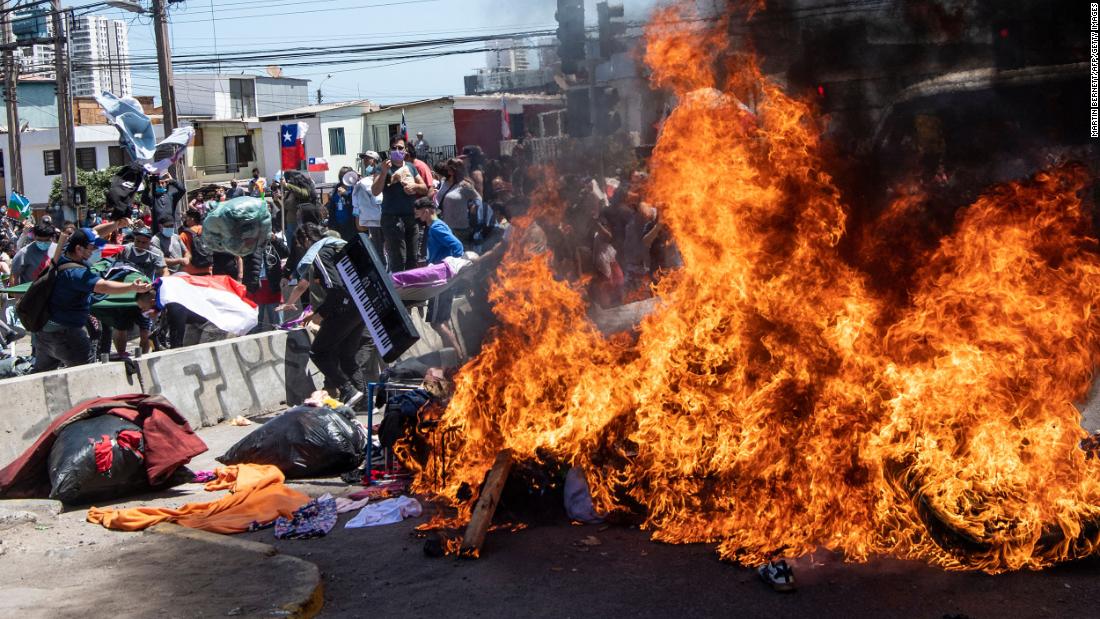Oyarzo, who went out to document the rally, said she reached the city’s waterfront and saw a group of protesters stop seven young Venezuelans, one of them missing a leg, and try to physically attack them. Other people intervened, but the attackers managed to snatch the migrants’ backpacks and told them they were “criminals” and “thieves.”
“It was terrible!” Oyarzo said. “The migrants were desperate because they were trapped between their attackers and the sea. They had no way out.”
Elsewhere in the city, protesters held Chilean flags and placards with messages that read “Dirty Venezuelans leave our country” or “Human Rights are for Chileans,” and chanted the national anthem. They yelled at the migrants, many of them families with young children, to go back to their country. Some even spat at them and set migrants’ clothes, strollers, toys, and mattresses on fire.
Changing patterns
“What is changing are the patterns, the governments´ response to the different flows and the effect they have on migrants´ lives.”
Almost 80% of them originated from somewhere else in South America and many are now on the move due to increasingly hardline stances on immigration in several countries, and because the pandemic has exacerbated already difficult living conditions and created jobs scarce.
Between 2000 and 2017, several South American leaders — including presidents in Argentina, Chile, Ecuador, and Bolivia — pushed for more progressive immigration laws that made it easier for migrants to cross borders, work legally and obtain resident visas. But the trend in policy has since reversed, with restrictions on movement gaining momentum.
Political tumult has also added pressure. Massive protests in Chile and Colombia, a coup in Bolivia, a political crisis that saw three different men assume Peru’s presidency within one week, and the entrenchment of Venezuela’s authoritarian regime have pushed millions of Latin Americans to set off in search of a better life.
“While traditionally there were Latin American countries that were the final destination for many migrants, currently all countries in the region have both migrants coming in to settle down and passing through,” said Doña-Reveco.
Venezuelans are central to the region’s current humanitarian crisis. Since Nicolás Maduro took power almost a decade ago, political turmoil and a plummeting economy have led Venezuela to collapse. Hyperinflation, power cuts, shortage of food, water and essential medication, as well as political persecution have pushed more than five million Venezuelans to leave their country, according to the IOM, of which 79% have moved to other nations in South America.
Venezuelan migration started with highly skilled professionals, who had the means to travel and settle in other countries without much trouble, but it has increasingly included poor, working-class people. Experts say the volume of this immigration is comparable to the Syrian refugee crisis.
“What has changed here more recently is the impact of the pandemic and the border closures to stop Covid-19,” she said. “Those who have been coming in the past few months are entering illegally and we estimate that only one-third of them traveled directly from Venezuela. The rest came from Colombia, Ecuador, or Peru because they lost their jobs there.”
Tapia said she recently took a woman and her four children, including a baby, to a shelter. The woman told Tapia that she had hitchhiked from Venezuela to Chile after her husband abandoned her, in hopes of reaching relatives in Santiago.
“They spent days without eating, depending on charity to survive,” Tapia said.
“We are going to see some very tense situations in the next weeks or months,” she added.
‘At first, I wanted to go back to Bolivia’
In Iquique, the migrant population has swelled in part because many migrants don´t have the Covid-19 vaccine required to continue their travel by bus or just can´t afford to continue their journey, experts say. This is happening in other countries as well, where border closures have trapped some migrants in a sort of limbo.
“There are people who were migrating when the pandemic started,” said Doña-Reveco.
“They wanted to go to Chile, for instance, where relatives were going to give them jobs. But when they reached Peru, borders closed, and they couldn’t continue to Chile. Their whole plan collapsed. They ran out of money, have no contacts and are stuck in makeshift camps.”
“Governments have the responsibility to protect those people to avoid the precarity and local populations’ negative reactions,” Martínez said. “There are international agreements that were signed, and Latin American countries should coordinate plans of action to face this emergency.”
One 26-year-old who didn’t want her name to be published because she fears being deported told CNN that she left Bolivia with her sister at the end of July. Neither could find work in their home country, and the few gigs that she tried — cleaning houses, as a cashier in a supermarket and in the production line of a drug manufacturing company — paid less than the local minimum wage. Both have children to feed.
They paid smugglers to take them to Chile first by minibus, then by foot, crossing through the altitude and cold of the Bolivian altiplano. “It was really scary because I didn’t know what would happen to us,” she said. “We didn’t know if we were going to get robbed, the cold was terrible, my head hurt, and because of the altitude, I felt as if my ears were going to explode. I almost fainted.”
During her journey, she saw entire families with small children crossing. Once in Chile, she was shocked by the number of migrants living in the streets. “It made me feel very sad; I felt like crying,” she said. “You see many things you couldn’t imagine, like parents stealing to be able to feed their children. At first, I wanted to go back to Bolivia, but couldn’t imagine having to cross like that again.”
Source link


